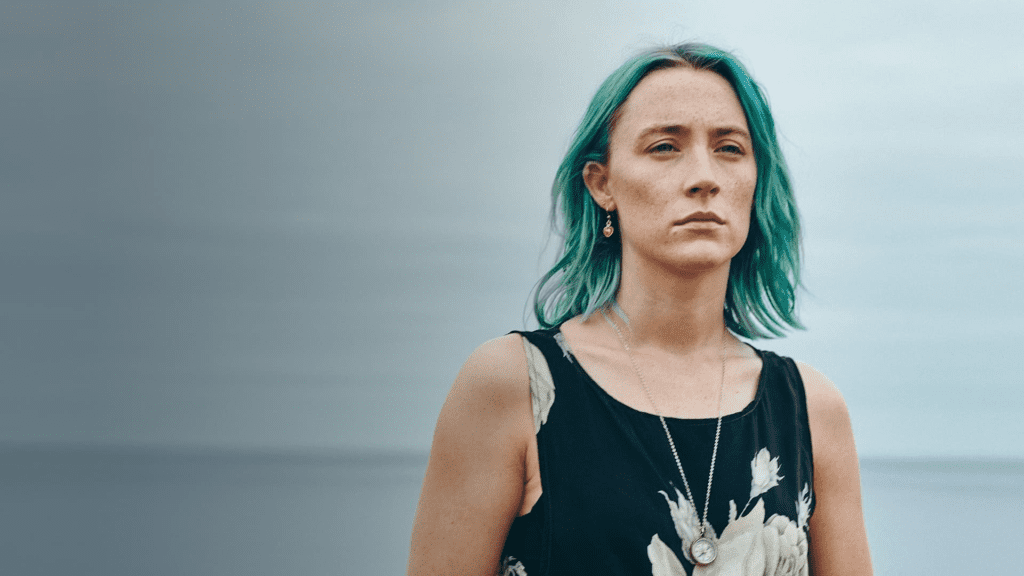The Outrun Review: A Mesmerizing Journey Through Addiction and Redemption
In The Outrun, directed by Nora Fingscheidt and starring the remarkable Saoirse Ronan, we’re taken on a sobering journey into the depths of addiction and the search for redemption. This adaptation of Amy Liptrot’s 2017 memoir is not just a film about recovery; it’s an exploration of how isolation, nature, and personal demons can converge in unexpected and sometimes dangerous ways. With breath taking landscapes, complex characters, and a raw portrayal of addiction, The Outrun delivers a powerful emotional punch. Let’s dive deeper into why this film stands out and what makes it resonate so deeply.

The Landscape as a Metaphor: Orkney’s Untamed Power
The film begins with Rona (Saoirse Ronan) returning to Orkney, a wild and windswept island in Scotland where she grew up. The land, like her, is untamed and rugged a reflection of the inner turmoil she battles throughout the film. The title “The Outrun” refers to an outlying, coastal piece of farmland that cannot be cultivated, constantly whipped by Atlantic winds. This setting serves as more than just a backdrop; it becomes a metaphor for Rona’s own struggle. Like the unforgiving land, she’s shaped by forces beyond her control her addiction, her troubled family, her sense of displacement.
But Orkney is not romanticized as a peaceful sanctuary. It’s raw, intimidating, and at times just as violent as the city life Rona escaped. The sense of isolation on the island mirrors her emotional state, creating a stark contrast to the fast-paced, chaotic existence she led in London. Is it possible to find peace in such a place, or is the island just another illusion of escape?
Saoirse Ronan’s Captivating Performance
Saoirse Ronan’s portrayal of Rona is nothing short of mesmerizing. She carries the film with a fierce intensity, delivering a performance that feels painfully real. From the chaotic highs of her addiction to the fragile moments of sobriety, Ronan immerses herself fully into the character. The complexity of portraying someone in the grips of addiction, yet striving for redemption, requires a delicate balance. Ronan nails this, conveying both the desperation and the small glimmers of hope that come with recovery.
There’s a particular scene where Rona, freshly sober, walks into a shop and is confronted with a row of liquor bottles. The tension is palpable as we watch her struggle internally, but what’s remarkable is how subtly Ronan plays it. There are no dramatic outbursts, no grand gestures just a quiet, controlled resistance that feels incredibly raw and authentic.
Addiction as an Unseen Force
One of the film’s strengths lies in how it portrays addiction not as something glamorous or sensationalized, but as an insidious force that silently chips away at a person’s life. The nonlinear narrative allows us to see Rona’s journey from different angles her moments of vulnerability, the chaos she caused in her relationships, and the fragile state of her recovery. Her battle with alcohol is not portrayed as a simple story of falling and rising. It’s a constant ebb and flow, much like the tides that surround the Orkney Islands.
In one scene, Rona confesses to her 12-step group that what she misses most is not the alcohol itself, but the feeling of euphoria that comes with it. This brutal honesty cuts deep, highlighting the psychological grip addiction can have, long after the physical cravings have faded. Her emotional dependence on alcohol is intertwined with her sense of identity, and breaking free from that is a painful process.
Family Ties and Emotional Burdens
Beyond addiction, The Outrun delves into Rona’s complicated family dynamics. Her father, Andrew (played by Stephen Dillane), struggles with bipolar disorder and alcoholism, while her mother, Annie (Saskia Reeves), has found solace in religion. Rona’s relationship with her parents is strained, and much of her emotional baggage stems from unresolved childhood trauma. The film masterfully portrays how family issues can contribute to a person’s struggles, and how confronting those demons is a necessary part of healing.
Rona’s relationship with her father is particularly poignant. She recognizes that her addictive tendencies may have been inherited from him whether through nature or nurture and this realization forces her to question whether she can truly separate herself from his legacy. Can she love her father while cutting him out of her life for her own survival? It’s a heart breaking dilemma, and one that The Outrun handles with grace and sensitivity.
The Mythology of Orkney: A Connection to the Past
One of the unique elements of The Outrun is its incorporation of Orkney’s folklore and mythology. As Rona reflects on her surroundings, we hear tales of selkies, sea creatures, and ancient legends that have been passed down through generations. These stories add a layer of mysticism to the film, blurring the line between reality and imagination. In one moment, Rona even jokes that she can control the weather “lightning strikes every time I sneeze, and when I orgasm, there’s an earthquake.”
These fantastical elements serve as a contrast to the stark realism of the film’s portrayal of addiction. They remind us that even in the darkest moments, there is room for wonder, for dreams, and for hope. The folklore becomes a way for Rona to connect with her roots and rediscover a sense of belonging, even as she struggles to reconcile her past with her present.
London vs. Orkney: A Tale of Two Worlds
Throughout the film, we see flashbacks of Rona’s life in London. The city is depicted as a place of both freedom and destruction a fast-paced world where she could lose herself in alcohol and parties, but where she also experienced deep loneliness and despair. The smoky, industrial clubs she frequented are a stark contrast to the open, windswept landscapes of Orkney.
But The Outrun avoids falling into the trap of painting London as a place of corruption and Orkney as a paradise. Both places have their challenges, and neither is a perfect escape. The film makes it clear that Rona’s journey is not about running away from her problems, but about facing them head-on, no matter where she is.
The Sound of Silence: How Sound Design Elevates the Film
The sound design in The Outrun plays a crucial role in conveying the film’s emotional depth. The howling winds of Orkney, the crashing waves, and the eerie silence of isolation all serve to immerse the viewer in Rona’s world. At times, the silence is deafening, mirroring the quiet battles she fights within herself.
When Rona steps onto a ferry, the cacophony of sounds people, machines, the clattering of metal becomes overwhelming. It’s a stark reminder that even though she’s leaving the island, the noise of the outside world can be just as oppressive as the isolation of Orkney.
A Story of Redemption and Resilience
The Outrun is a powerful exploration of addiction, isolation, and the journey toward redemption. Saoirse Ronan’s performance anchors the film, bringing a raw intensity and emotional depth that elevates the story beyond a typical addiction drama. With its stunning landscapes, complex characters, and unflinching portrayal of recovery, The Outrun leaves a lasting impact.
Whether you’re someone who has faced addiction personally or have watched a loved one struggle, The Outrun offers a poignant reminder of the resilience of the human spirit. It’s a story about finding strength in the most unlikely places, and about learning to live with the scars of the past while holding onto hope for the future.





